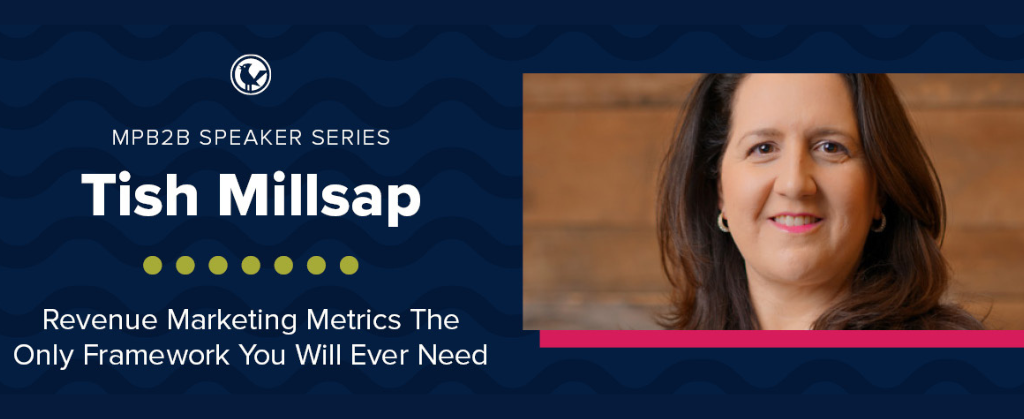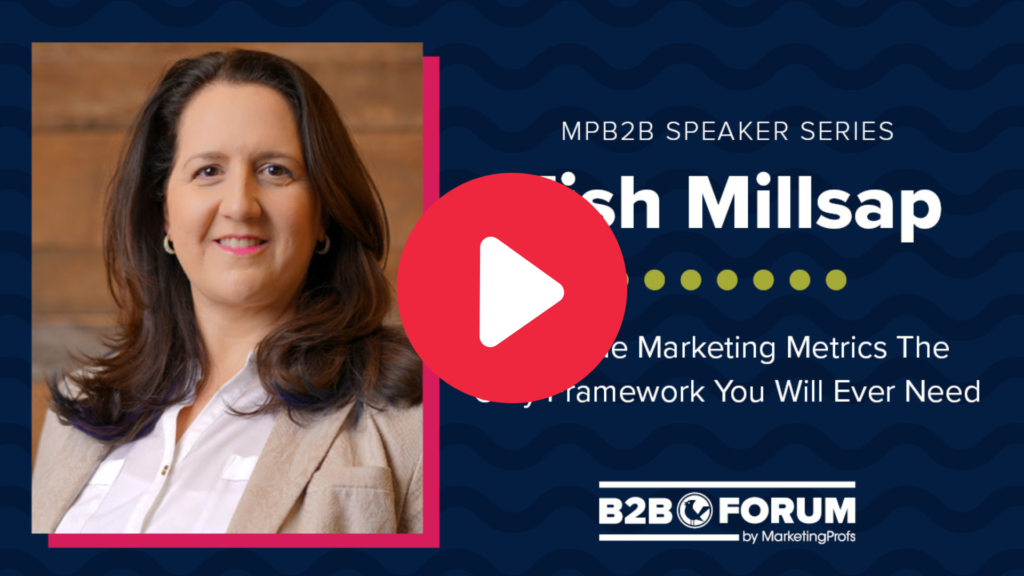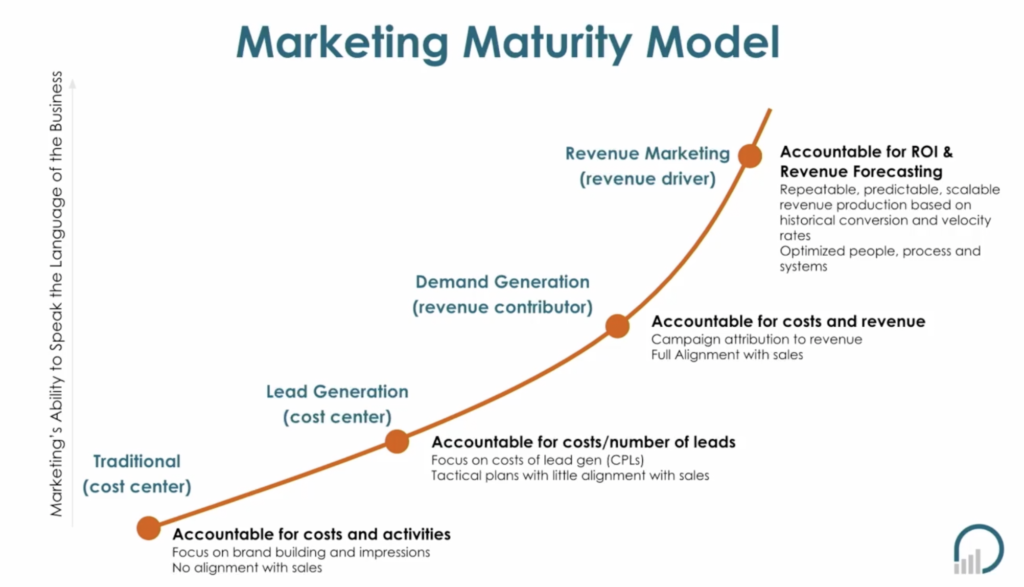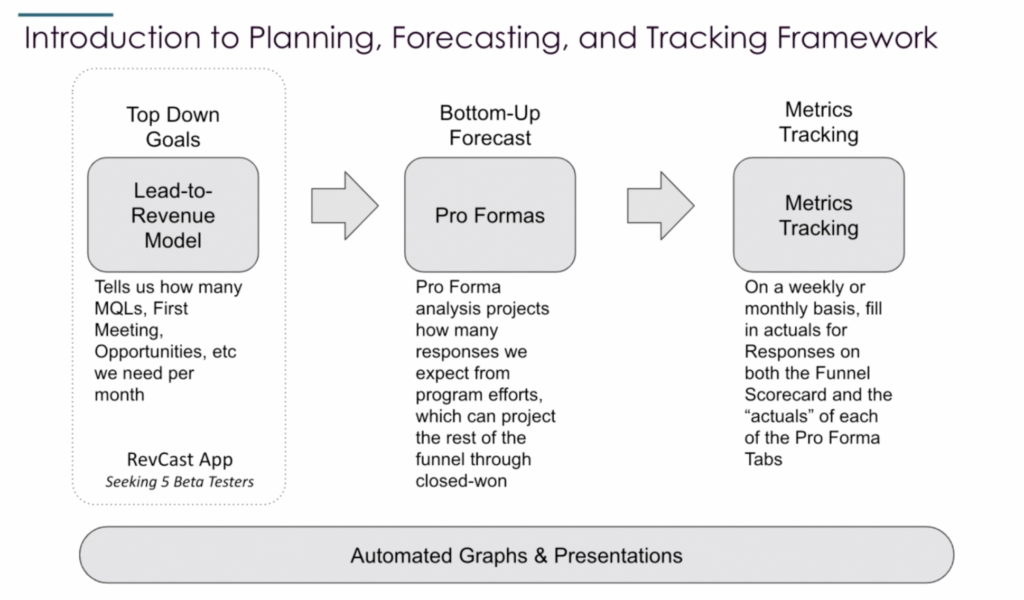
Marketing drives revenue. But it’s often seen as a cost center instead of a driver. Which makes marketing vulnerable to budget cuts.
So how do you correct this perception in your organization?
In this clip from B2B Forum 2022, Tish Millsap (CEO of Revenate Marketing) shares her insights on translating your marketing language into the language of business.
Watch the clip from Tish’s session or read the transcript below.

This is something I call the marketing maturity model. And it’s really the core of the work that I do with my clients. It’s all about enabling marketing to be seen as a revenue driver and not as a cost center. Because it’s really easy to cut the budget of a cost center. Much more difficult to cut the budget of a revenue driver.
And how do you become seen in the organization as a revenue driver?

Well, my belief is that you have to be speaking the language of the business. So that means you don’t talk to people (outside of the marketing department) about things like click rates, and how many people filled out our form, or things like that.
[Instead,] you wanna be able to translate those things that are important to us into the things that matter to the rest of the business, which is: driving revenue.
At the first level of this model—and I usually go in and do an assessment with my clients, where are you right now?—but [at the first level] you’re just reporting out activities. How much those activities cost.
And most teams these days, modern marketing teams have moved beyond that. They’re really doing lead gen. They’re accountable for a certain number of leads. They really are looking at their cost at a cost per lead basis or cost per customer required basis.
And then the next level is the demand gen level. And this is where you’ve really gotten to the point that you can look backwards, see what you did, and then you can attribute revenue to that.
And this is, you know, a huge accomplishment to get this done. You have to have a lot of processes and systems in place to get to that.
But it really is only a look backwards. And the holy grail to me is to really be able to actually forecast what’s gonna happen based on the marketing activities that you have planned.
And this is what this framework is gonna help you do. And this is what is important when it comes time to allocating budget to marketing. You need to know that your plan is gonna meet the goals. And if there’s a shortfall, what you wanna do.
So sounds great, right? And this is all stuff that you’d wanna be able to do. But I do wanna be honest with you. This is not an easy path.
I’ve worked with a lot of clients. Some work faster than others. Sometimes when the CMO has moved to a new company, he or she brings me on board and says, “I want that same thing we did before and we can build it really fast.” But sometimes it takes a year to build out this kind of stuff.
But what I’ve learned with the clients I’ve worked with that have more difficulty, it really comes down to three things.
You have to be able to consistently follow a process.
You have to be able to plan in advance. I still work with teams where the email that’s going out tomorrow isn’t proofed and done.
And you have to be agile. And the agility is really important, because you need to be able to respond when the system is telling you that you are not driving enough engagement to meet the goals. You have to be able to change your plan and do something different. Otherwise there’s no point in doing all this work.
All right, so what does this framework do?

It does four things. And the first three are the numbers that I think are most important to us.
One is the goal number.
Two is the forecast number.
And three is the actuals number.
So the goal number needs to be figured out. I use something called a lead to revenue model and it tells us based on the revenue goals of the company: what does marketing need to do and when, how many MQL do I need to deliver and when do I need to deliver them, to be completely aligned with the revenue goals of the company.
For this part of the framework, I’ve developed an app, it’s called RevCast. It does a lot of this automatically.
So the second piece is the forecast number. And this is, how do I know that my plan, my marketing plan that I put together, is gonna meet the revenue goals of the company?
So to do this, we build a bottoms-up plan. We look at everything that’s going to happen, what events you’re gonna do, what emails you’re gonna send out, and basically ensure that it’s gonna meet the future revenue goals of the company.
And the third number is actuals, which many of you guys are already tracking. I’m gonna talk a little bit about what exactly I mean by that. But it’s a really important starting point for the whole system and having a baseline—at least three months worth of data—before you start doing the forecasting and revenue modeling pieces of this. It’s really important cuz you need some benchmarks, otherwise you’re gonna be guessing about a lot of this.
And the fourth part of this is the automated graphs and presentations. So the way I have this system set up is that you just basically put in your numbers into the spreadsheets, and it automatically chugs out all the charts and graphs that you need.
And what’s great about this is that, when you’re getting ready for a board meeting or a QBR or something like this, you’re not scrambling to pull together the data that your CMO needs for that. They have it at their fingertips.
And so what you really get to spend time doing is, what is the story behind this data?
Not having this system in place right now is kind of painful for me for some clients, because we do that mad scramble. And I’m sure all of you guys do it too, in terms of trying to get numbers together when you need to.
If it’s already set up for you, just makes it so much easier.
Published 7/5/23
B2B Forum is packed with marketing insights, strategies, and tactics taken from the real world experience of over forty industry experts, packaged into context you can actually put to use.
Join us in Boston for B2B Forum 2024 this coming November 12-14, 2024. Early buyers get B2B Forum tickets at their lowest rate, and discounted hotel rooms are available while they last.